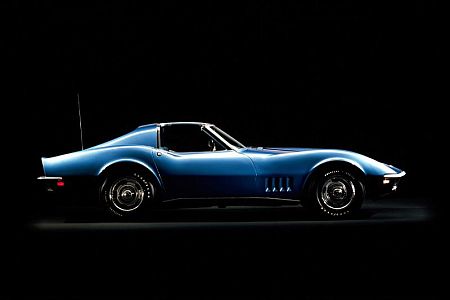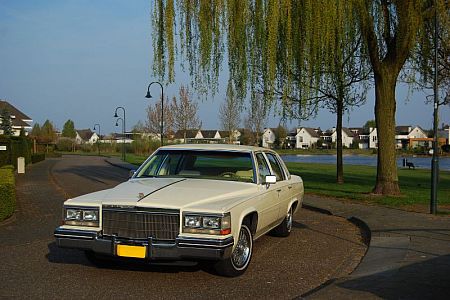Cadillac De Ville, Fleetwood Brougham and Fleetwood Limousine
An imposing giant with a sturdy chassis, rear-wheel drive, usually a powerful V8 engine under the bonnet and a luxurious interior. What more could a true lover of classic American cars desire? If you have this wish list, then the Cadillac De Ville, Fleetwood Brougham and Fleetwood Limousine are right for you.
Take, for instance, the generation introduced in 1977. These cars are true flagships of General Motors' top division, although technically they have some areas of concern.

Introducing the De Ville and Fleetwood
It almost sounds funny when we say that these Cadillacs were born from a process of downsizing. For the 1977 model year, which is equivalent to mid-1976, the sedans became significantly smaller and lost hundreds of pounds in weight. General Motors gave in to US emissions regulations, with the state of California leading the way.
The design of the De Ville and its luxury Fleetwood brother was not initially met with much enthusiasm, but that changed after two years, when designers took a thorough approach to the bodywork. The result would remain virtually unchanged for almost a decade, only to undergo another facelift.
Smaller and lighter
With the aim of reducing fuel consumption, the engineers made every effort to remove unnecessary steel and other materials that negatively affected weight. In this way, they managed to bring the weight below two tonnes.

Although the De Ville and Fleetwood were more compact compared to their predecessors, they were still substantial in size. Nor did they have to be ashamed of their six-litre V8 engine, which incidentally produced only modest power. As an alternative, Cadillac offered a genuine diesel engine from Oldsmobile's stable, with a capacity of 5.7 litres and based on a petrol block. The propulsion system was tuned for the heavier loads that such a self-igniter has to endure internally, but despite this, durability was somewhat disappointing.
Technical challenges and unconventional choices
Notable was the fact that from 1980, a six-cylinder Buick engine was on the programme, with a modest capacity of just 4.1 litres. This was actually too small for these big cars.
As a novelty, Cadillac introduced advanced cylinder deactivation on the 6.0 engine during that year. This V8-6-4, equipped with fuel injection, adjusted the number of working cylinders based on power requirements, thanks to a number of sensors.
However, electronics in cars were still in the early stages and these Cadillacs caused problems for their owners and garages alike. After just one year, the manufacturer decided to scrap this engine, except for the Limousine, which was considered too heavy for the new 4.1 V8.
In fact, the same applied to the De Ville and the Fleetwood Brougham, but management seemed to care little. Meanwhile, the old-fashioned 6.0 V8 with carburettors remained available only on a chassis for coachbuilders, who built, for example, hearse cars or extra spacious limousines.
Cadillac De Ville and Fleetwood Brougham: evolution and changes
The range of both the De Ville and the Fleetwood Brougham also included a Coupé, the latter having a smaller-sized side window that was incorporated into the vinyl roof covering. The Fleetwoods were distinguished anyway by more chrome and a more luxurious interior, with stitched upholstery, for example.

In 1984, Cadillac pulled the fullsize De Ville from the market to make way for a much more efficient (or smaller) model with front-wheel drive and a lack of charisma. However, the Fleetwood Brougham persisted and was even regularly further developed. For instance, the 4.1 engine was replaced by a 5.0 V8 sourced from Oldsmobile, and various detail improvements were made each year.
From the second half of 1986, the word Fleetwood was omitted from the model designation. The Brougham had its own customer base and Cadillac clearly did not want to miss out on it, so it received a visible update for the 1990 model year.
Fuel choices and driving experience
It is worth noting that Cadillac did not export the diesel variants of the De Ville and Fleetwood to Europe, which is actually not a big omission. All petrol engines run on LPG without any problems, so that is the best choice if you want to drive as economically as possible. Such a gas tank takes up only a small piece of the huge boot space.

Driving a traditional Cadillac requires a certain attitude: let go of the rush. The soft suspension, indirect steering, balloon tyres and laid-back engines will automatically make you drive leisurely. In that respect, the modest 4.1 engines do their job well, even if they are often ridiculed within the Cadillac community. If you want the ultimate drive, opt for a 1979/1980 6.0 or a later 5.0.
What should you look out for when buying a Cadillac?
The De Ville and especially the much-loved and slightly more expensive Fleetwood surround you with all sorts of luxuries, including climate control and options like an automatic dimming interior mirror and cruise control. Unfortunately, the more of these indulgences, the greater the chance of breakdowns, and that can sometimes be a challenge to fix, with associated costs if you get it fixed.
These models are not among the best in Cadillac's history. Be careful with neglected ones, as they can turn into a financial drama. If you start with a healthy one, you won't have to worry in that respect, because apart from the occasional unpleasant surprises, maintenance costs and part prices are very reasonable. Then you will enjoy a truly top-class experience.




